外研版(2019)选择性必修 第四册Unit 3 The world meets China Using language Grammar&Vocabulary课件(共43张PPT)
文档属性
| 名称 | 外研版(2019)选择性必修 第四册Unit 3 The world meets China Using language Grammar&Vocabulary课件(共43张PPT) |  | |
| 格式 | pptx | ||
| 文件大小 | 7.1MB | ||
| 资源类型 | 教案 | ||
| 版本资源 | 外研版(2019) | ||
| 科目 | 英语 | ||
| 更新时间 | 2024-05-01 22:31:48 | ||
图片预览

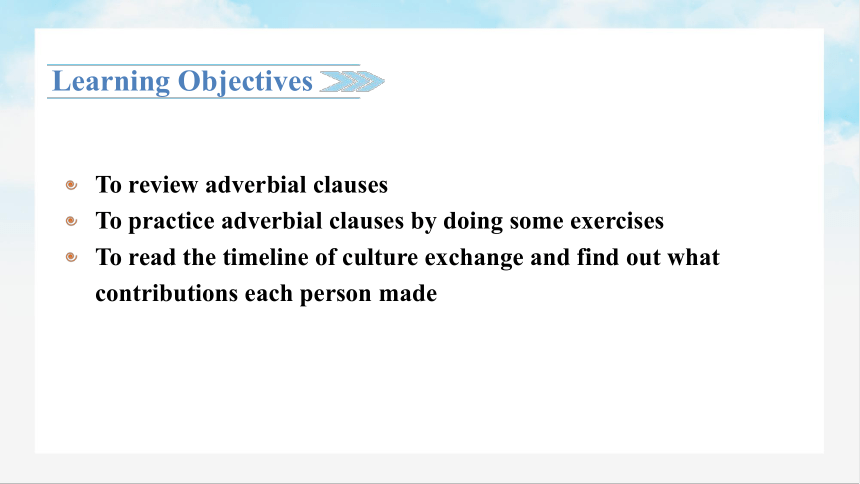
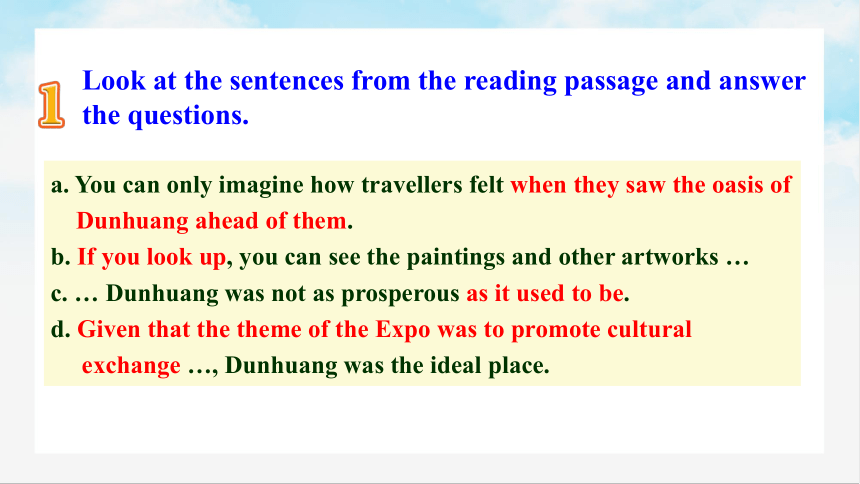
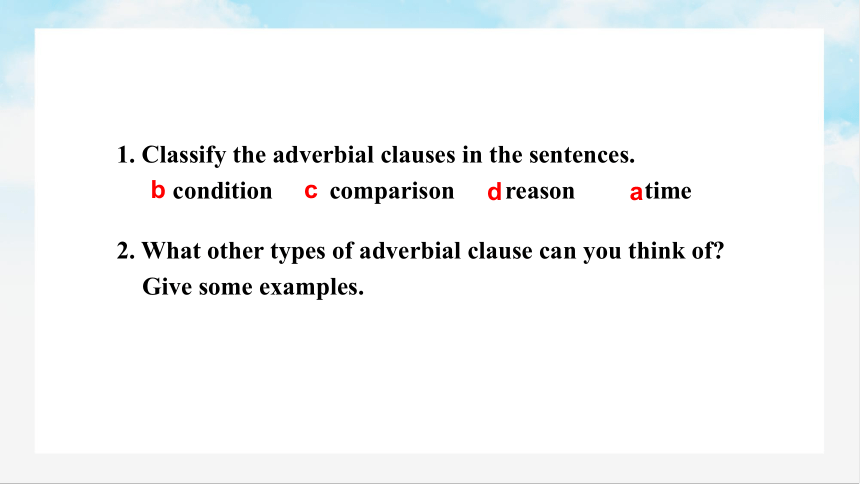
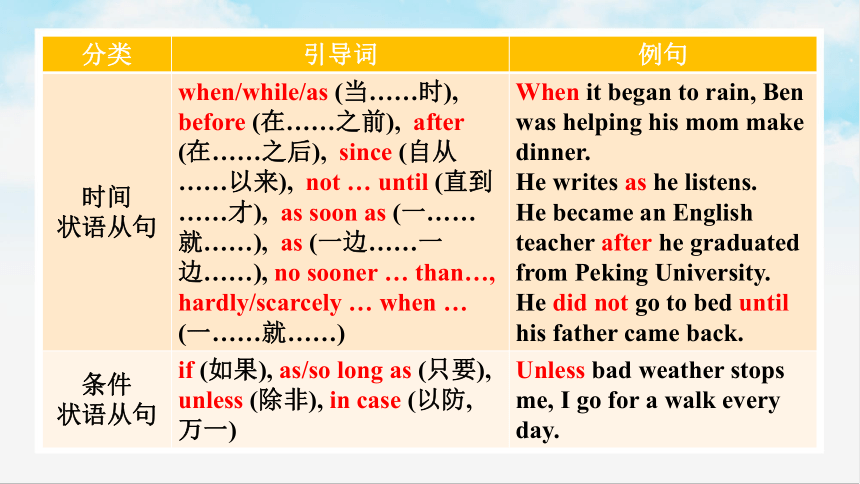
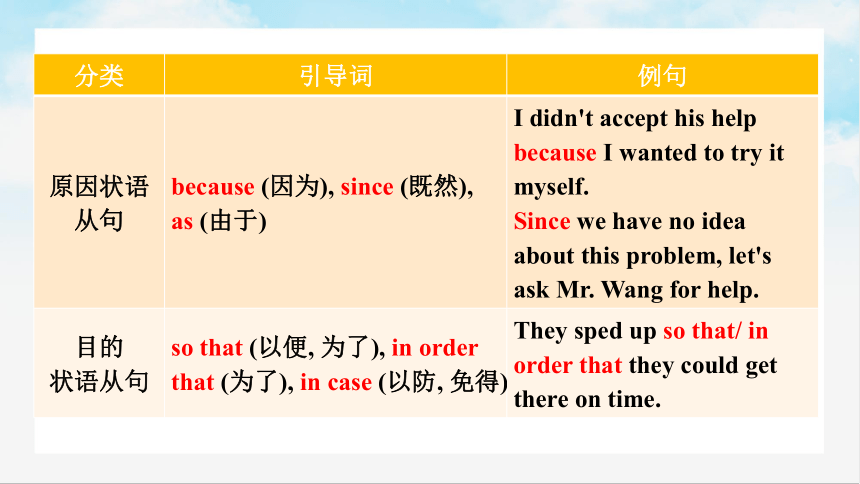



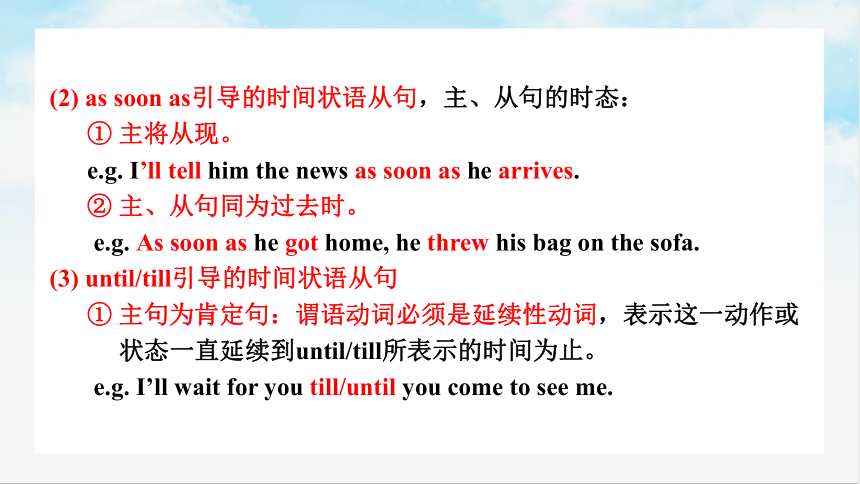
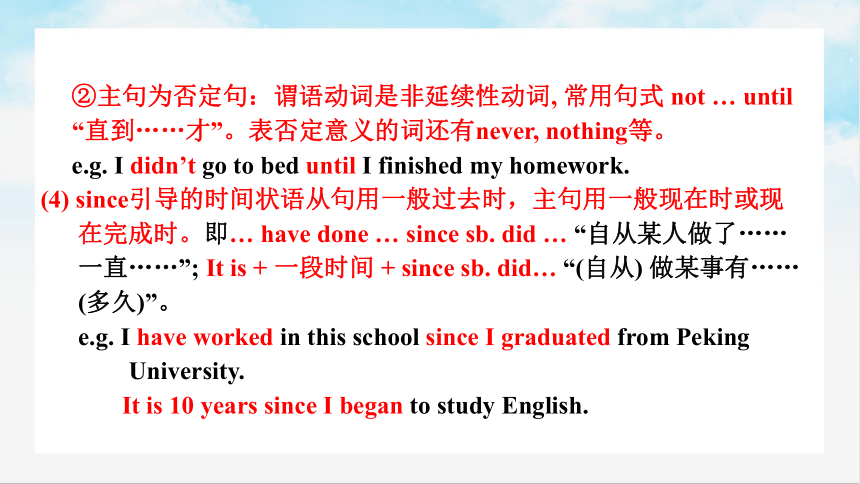
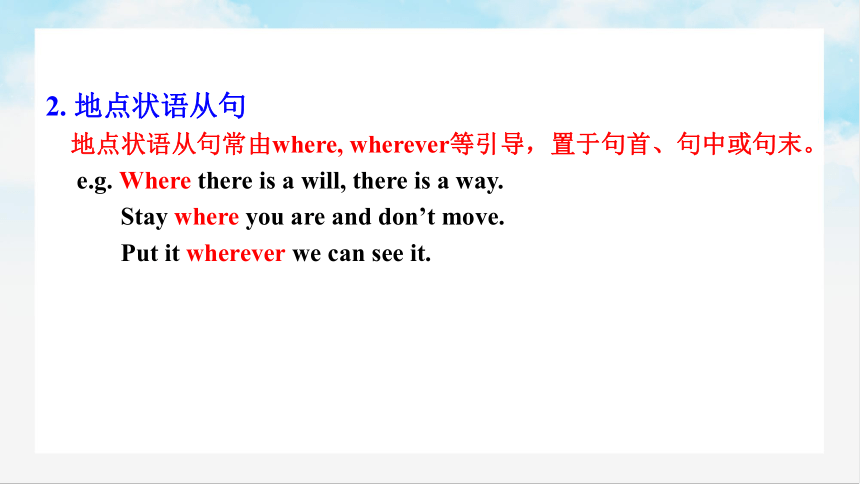
文档简介
(共43张PPT)
Review: adverbial clauses
Unit 3 The world meets China
Grammar
To review adverbial clauses
To practice adverbial clauses by doing some exercises
To read the timeline of culture exchange and find out what contributions each person made
Learning Objectives
Look at the sentences from the reading passage and answer the questions.
a. You can only imagine how travellers felt when they saw the oasis of Dunhuang ahead of them.
b. If you look up, you can see the paintings and other artworks …
c. … Dunhuang was not as prosperous as it used to be.
d. Given that the theme of the Expo was to promote cultural exchange …, Dunhuang was the ideal place.
1. Classify the adverbial clauses in the sentences.
condition comparison reason time
b
c
d
a
2. What other types of adverbial clause can you think of Give some examples.
分类 引导词 例句
时间 状语从句 when/while/as (当……时), before (在……之前), after (在……之后), since (自从 ……以来), not … until (直到 ……才), as soon as (一…… 就……), as (一边……一边……), no sooner … than…, hardly/scarcely … when … (一……就……) When it began to rain, Ben was helping his mom make dinner.
He writes as he listens.
He became an English teacher after he graduated from Peking University.
He did not go to bed until his father came back.
条件 状语从句 if (如果), as/so long as (只要), unless (除非), in case (以防, 万一) Unless bad weather stops me, I go for a walk every day.
分类 引导词 例句
原因状语从句 because (因为), since (既然), as (由于) I didn't accept his help because I wanted to try it myself.
Since we have no idea about this problem, let's ask Mr. Wang for help.
目的 状语从句 so that (以便, 为了), in order that (为了), in case (以防, 免得) They sped up so that/ in order that they could get there on time.
分类 引导词 例句
结果 状语从句 so … that / such … that (如此……以至于) It’s so hot that nobody wants to go out.
让步 状语从句 though/although (尽管, 虽然), even though/if (即使), whether … or … (不管……还是……), whatever (无论什么), whenever (无论何时), wherever (无论哪里) Although milk is good, you should not drink too much of it.
Whatever you want to be, you need to work hard to achieve it.
分类 引导词 例句
比较 状语从句 than (比……), as … as (和 ……一样), not as/so … as (不如……) He is as tall as his brother.
地点 状语从句 where (……的地方), wherever (无论哪里) Where there is a will, there is a way.
You can sit wherever you like.
方式 状语从句 as if/though (好像, 似乎), as (按照) It looks as if it is going to rain.
Use a book as a bee does a flower.
1. 时间状语从句
(1) when引导的时间状语从句,主句是一般将来时或祈使句,表示将来的意义时,从句通常用一般现在时。(简称 “主将从现” “主祈从现” )。
e.g. When he comes here, I will call you.
while引导的时间状语从句表示正在发生某事的同时,另一件事发生了或正在发生。多用进行时态,主句时态视情况而定。
e.g. While the teacher is speaking, I am listening carefully.
(2) as soon as引导的时间状语从句,主、从句的时态:
① 主将从现。
e.g. I’ll tell him the news as soon as he arrives.
② 主、从句同为过去时。
e.g. As soon as he got home, he threw his bag on the sofa.
(3) until/till引导的时间状语从句
① 主句为肯定句:谓语动词必须是延续性动词,表示这一动作或状态一直延续到until/till所表示的时间为止。
e.g. I’ll wait for you till/until you come to see me.
②主句为否定句:谓语动词是非延续性动词, 常用句式 not … until “直到……才”。表否定意义的词还有never, nothing等。
e.g. I didn’t go to bed until I finished my homework.
(4) since引导的时间状语从句用一般过去时,主句用一般现在时或现在完成时。即… have done … since sb. did … “自从某人做了……一直……”; It is + 一段时间 + since sb. did… “(自从) 做某事有…… (多久)”。
e.g. I have worked in this school since I graduated from Peking University.
It is 10 years since I began to study English.
2. 地点状语从句
地点状语从句常由where, wherever等引导,置于句首、句中或句末。
e.g. Where there is a will, there is a way.
Stay where you are and don’t move.
Put it wherever we can see it.
3. 条件状语从句
(1) 时态: 主句为一般将来时或含有情态动词,从句用一般现在时。
e.g. I’ll visit the Great Wall if it doesn’t rain tomorrow.
We can’t pass the exam unless we study hard.
(2) “祈使句, + and/or + 陈述句”中,祈使句在意义上相当于一个条件状语从句。
e.g. Use your head, and you’ll find a way.
= If you use your head, you’ll find a way.
(3) if是最常用的引导条件状语从句的连词,它表达的假设既可以是真实的条件,也可以是虚拟的条件。
e.g. If everyone does his part, the project will surely be a success.
If I were you, I wouldn’t go without saying goodbye.
(4) unless 意为 “如果不, 除非”, 相当于if … not …。
e.g. Unless you make up your mind, I won’t be able to help you.
(5) so/as long as, on condition that 意为 “只要”。
e.g. So long as you run the marathon, you have the chance of winning a medal.
I will do it on condition that you help me.
(6) in case 意为 “以防,万一”, 引导的从句为主句的动作提供假设或理由。
e.g. You’d better have a snack in case there is no time to eat later.
4. 原因状语从句
(1) 通常用because, since, as 引导原因状语从句。回答why提出的问题用because。
e.g. I didn’t go to the movies because I have to finish my report.
(2) 如果原因是人们已知的事实,就要用since “既然”引导。
e.g. Since you can’t answer the question, you can ask someone else for help.
5. 目的状语从句
(1) 引导词(组): so that, in order that等。从句谓语中常含有may, can, must, will等情态动词。
e.g. He must get up early so that he can go to work on time.
(2) 当主、从句的主语一致时,从句可用 “so as to/in order to + 动词原型”代替。
e.g. He worked day and night in order that he could succeed. = He worked day and night in order to succeed.
6. 结果状语从句
(1) 如此……以致于……
so + 形容词 / 副词 + that
such + a / an + 形容词 + 单数可数名词 + that
such + 形容词 + 复数可数名词/不可数名词 + that
so + 形容词 + a / an + 单数可数名词 + that
当名词前面有many或much修饰时,用so而不用such。
e.g. He is such a young boy that he can’t go to school. =
The boy is so young that he can’t go to school.
(2) so … that 句型的否定形式可用too … to … 或 not … enough to构成的简单句代替。
e.g. He is so young that he can’t go to school.
= He is too young to go to school.
= He is not old enough to go to school.
7. 让步状语从句
(1) although, though, even if/though都作 “虽然,尽管”讲。
e.g. He will never tell you the truth even if he knows it.
The old woman is unhappy though she has a lot of money.
(2) as引导让步状语从句时,把表语提前构成倒装,通常可换成though。作表语的单数可数名词前如有冠词,冠词需要省去。
e.g. Young as/though she is, she knows so much about life.
We have so much time that we can finish the work very well.
(3) whether … or … “不管…….还是……”
e.g. Whether we can go or not, you guarantee to finish your homework.
(4) whatever, whoever, wherever, whenever, however和 “no matter + what/who/where/when/how” 都可以引导让步状语从句,可以互换。
e.g. Whatever/No matter what happened, he would not mind.
8. 比较状语从句
比较状语从句常由 as … as …(和……一样), not so/as … as … (不如……那样……), than (比)引导。
e.g. You are as tall as your father (is).
9. 方式状语从句
方式状语从句通常由as if/though(好像, 似乎), as (按照)引导。
e.g. It looks as if it is going to rain.
Use a book as a bee does a flower.
Now look for more sentences with adverbial clauses in the reading passage.
Come a little bit closer so that you can get a better view.
The Apsaras are depicted sailing in the bright blue sky, with their scarves flying, as if they are about to fly down to meet us.
Move over here where you can see it in more detail.
Now, something really extraordinary happened in 1900, when a Taoist priest made one of the most important finds of the 20th century.
The scrolls are so detailed that they describe the vast range of goods that were imported and exported from Dunhuang.
Gradually, it faded from memory, even though it was once such a great city.
Dunhuang has once again become a global crossroads since it hosted hundreds of representatives from 51 countries for the Silk Road International Cultural Expo in 2017.
Complete the passage with the clauses in the box.
no matter what culture it comes from
so that people can learn about different cultures
as if they are neighbours
that over 15,000 people each year attend them
as the traditional is mixed with the modern
Yo-Yo Ma is a French-born Chinese American cellist known for his musical talent. In 1998, Ma founded Silkroad, an organisation that explores musical traditions in countries 1. _________________________________________________.
so that people can learn about different cultures
purpose
Practice
The fundamental purpose of Silkroad is to bring people from across the globe together to play and listen to music. Instruments and styles are blended together to create music that is surprising, rich, and completely original, 2. __________________________________. What's more, 3. _______________________________________,
no matter what culture it comes from
as the traditional is mixed with the modern
concession
reason
no matter what culture it comes from
so that people can learn about different cultures
as if they are neighbours
that over 15,000 people each year attend them
as the traditional is mixed with the modern
people can learn about the development of culture as a whole.
The events that Silkroad organises are either performances, workshops, or mixed musical-artistic displays. It is so successful 4.________________________________________. People meet as strangers, but they leave 5. ____________________________, learning that different cultures have more in common than they imagined.
that over 15,000 people each year attend them
as if they are neighbours
result
manner
no matter what culture it comes from
so that people can learn about different cultures
as if they are neighbours
that over 15,000 people each year attend them
as the traditional is mixed with the modern
When an intercity high-speed train pulled out of Beijing South Station in 2008, China’s rail network had ushered in (开启) a new fast-moving era. Over the past decade, China has added over 35,000 kilometers to its high-speed rail (HSR) network, with the total length that far exceeds the rest of the world combined. Train speeds have increased from a maximum of 200 km per hour to 350 km per hour – the fastest in the world. Here is a video to get more.
Chinese Innovation
Look at the picture and describe it using adverbial clauses where appropriate. You may use the information to help you.
China’s High Speed Rail (HSR)
In 2008, China's HSR service started.
In 2015, a major breakthrough in technology was made, using independent R&D.
Now, China cooperates with dozens of countries in the world to develop HSR services overseas.
Since HSR service started in China in 2008, it has undergone rapid growth…
Since HSR service started in China in 2008, it has undergone rapid growth. The experience of train travel becomes much more efficient and enjoyable than before because journeys are not only much faster but also more comfortable. China's HSR had another technological leap when a major breakthrough was made in 2015, using independent R&D. Travellers have become so accustomed to the incredible speed of HSR that many of us have already forgotten the old, slow trains of just a decade ago. Now, China cooperates with dozens of countries around the world in order to share its groundbreaking technology and develop HSR services overseas.
Describe another Chinese innovation that has had a great impact both at home and abroad. Use adverbial clauses where appropriate.
Read the timeline and find out what contributions each person made. Pay attention to the expressions in red.
Cultural exchange
Zhang Qian, a diplomat, gave a reliable account of the lands of Central Asia for the Han court.
The second century BC:
Zhang Qian gave a reliable account for the lands of Central Asia for the Han court.
Gan Ying, a military envoy, explored the Persian Gulf and became the first Chinese to get information on Europe.
The first century AD:
Gan Ying became the first Chinese to get information on Europe.
Xuanzang, a Chinese monk, scholar and traveller, translated volumes of scriptures from Sanskrit (梵文) to Chinese. He also wrote The Great Tang Dynasty Record of the Western Regions, a description of the countries he visited on his travels.
The 7th century:
Xuanzang translated volumes of scriptures from Sanskrit to Chinese and wrote The Great Tang Dynasty Record of the Western Regions.
After six attempts, over a period of twelve years, Chinese monk Jianzhen arrived in Japan, where he promoted exchange and understanding between China and Japan.
The 8th century:
Jianzhen promoted exchange and understanding between China and Japan.
Marco Polo travelled from Europe to Asia. The travels of Marco Polo served to bring knowledge of Asia to the West.
The 13th century:
Marco Polo’s The Travels of Marco Polo served to bring knowledge of Asia to the West.
Zheng He sailed to South-east Asia, South Asia, West Asia, and East Africa. Some of his voyages comprised as many as sixty treasure ships. These voyages led to a legacy of cultural exchange between China and other countries.
The 15th century:
Zheng He’s extensive voyages led to a legacy of cultural exchange between China and other countries.
Complete the passage with the correct form of the expressions in Activity 5.
Qian Zhongshu was a renowned literary scholar and writer. Born in 1910 in Jiangsu Province, he showed a strong interest in books at a very young age, earning him the name “Zhongshu”, which means fondness for books. His translations and writings 1. _________________ of cultural exchange between China and the West that continues to this day.
led to a legacy
In 1929, Qian was accepted into the Department of Foreign Languages at Tsinghua University. In 1935, he went to Europe. He spent two years at Oxford University, where he studied and 2. ___________________ English literature. He also studied in Paris for a year, before returning to China to teach. In addition to studying Western literature, he wrote a number of works on Chinese culture.
got information on
Qian was an expert in both Chinese and Western languages and culture. This made him an excellent translator, who 3. ________ __________________________ between Western and Chinese academics. Selected and Annotated Song Dynasty Poetry was one of the many works he 4. _____________________ Chinese to English. One of Qian's great achievements was to produce comparative studies of classical Chinese texts, which made these works more accessible to Western readers. These books helped 5. __________________ Chinese literature to the West.
exchange and understanding
translated from
bring knowledge of
promoted
Write about another Chinese innovation that has had a great impact on you. You can try to use adverbial clauses where appropriate.
Homework
Review: adverbial clauses
Unit 3 The world meets China
Grammar
To review adverbial clauses
To practice adverbial clauses by doing some exercises
To read the timeline of culture exchange and find out what contributions each person made
Learning Objectives
Look at the sentences from the reading passage and answer the questions.
a. You can only imagine how travellers felt when they saw the oasis of Dunhuang ahead of them.
b. If you look up, you can see the paintings and other artworks …
c. … Dunhuang was not as prosperous as it used to be.
d. Given that the theme of the Expo was to promote cultural exchange …, Dunhuang was the ideal place.
1. Classify the adverbial clauses in the sentences.
condition comparison reason time
b
c
d
a
2. What other types of adverbial clause can you think of Give some examples.
分类 引导词 例句
时间 状语从句 when/while/as (当……时), before (在……之前), after (在……之后), since (自从 ……以来), not … until (直到 ……才), as soon as (一…… 就……), as (一边……一边……), no sooner … than…, hardly/scarcely … when … (一……就……) When it began to rain, Ben was helping his mom make dinner.
He writes as he listens.
He became an English teacher after he graduated from Peking University.
He did not go to bed until his father came back.
条件 状语从句 if (如果), as/so long as (只要), unless (除非), in case (以防, 万一) Unless bad weather stops me, I go for a walk every day.
分类 引导词 例句
原因状语从句 because (因为), since (既然), as (由于) I didn't accept his help because I wanted to try it myself.
Since we have no idea about this problem, let's ask Mr. Wang for help.
目的 状语从句 so that (以便, 为了), in order that (为了), in case (以防, 免得) They sped up so that/ in order that they could get there on time.
分类 引导词 例句
结果 状语从句 so … that / such … that (如此……以至于) It’s so hot that nobody wants to go out.
让步 状语从句 though/although (尽管, 虽然), even though/if (即使), whether … or … (不管……还是……), whatever (无论什么), whenever (无论何时), wherever (无论哪里) Although milk is good, you should not drink too much of it.
Whatever you want to be, you need to work hard to achieve it.
分类 引导词 例句
比较 状语从句 than (比……), as … as (和 ……一样), not as/so … as (不如……) He is as tall as his brother.
地点 状语从句 where (……的地方), wherever (无论哪里) Where there is a will, there is a way.
You can sit wherever you like.
方式 状语从句 as if/though (好像, 似乎), as (按照) It looks as if it is going to rain.
Use a book as a bee does a flower.
1. 时间状语从句
(1) when引导的时间状语从句,主句是一般将来时或祈使句,表示将来的意义时,从句通常用一般现在时。(简称 “主将从现” “主祈从现” )。
e.g. When he comes here, I will call you.
while引导的时间状语从句表示正在发生某事的同时,另一件事发生了或正在发生。多用进行时态,主句时态视情况而定。
e.g. While the teacher is speaking, I am listening carefully.
(2) as soon as引导的时间状语从句,主、从句的时态:
① 主将从现。
e.g. I’ll tell him the news as soon as he arrives.
② 主、从句同为过去时。
e.g. As soon as he got home, he threw his bag on the sofa.
(3) until/till引导的时间状语从句
① 主句为肯定句:谓语动词必须是延续性动词,表示这一动作或状态一直延续到until/till所表示的时间为止。
e.g. I’ll wait for you till/until you come to see me.
②主句为否定句:谓语动词是非延续性动词, 常用句式 not … until “直到……才”。表否定意义的词还有never, nothing等。
e.g. I didn’t go to bed until I finished my homework.
(4) since引导的时间状语从句用一般过去时,主句用一般现在时或现在完成时。即… have done … since sb. did … “自从某人做了……一直……”; It is + 一段时间 + since sb. did… “(自从) 做某事有…… (多久)”。
e.g. I have worked in this school since I graduated from Peking University.
It is 10 years since I began to study English.
2. 地点状语从句
地点状语从句常由where, wherever等引导,置于句首、句中或句末。
e.g. Where there is a will, there is a way.
Stay where you are and don’t move.
Put it wherever we can see it.
3. 条件状语从句
(1) 时态: 主句为一般将来时或含有情态动词,从句用一般现在时。
e.g. I’ll visit the Great Wall if it doesn’t rain tomorrow.
We can’t pass the exam unless we study hard.
(2) “祈使句, + and/or + 陈述句”中,祈使句在意义上相当于一个条件状语从句。
e.g. Use your head, and you’ll find a way.
= If you use your head, you’ll find a way.
(3) if是最常用的引导条件状语从句的连词,它表达的假设既可以是真实的条件,也可以是虚拟的条件。
e.g. If everyone does his part, the project will surely be a success.
If I were you, I wouldn’t go without saying goodbye.
(4) unless 意为 “如果不, 除非”, 相当于if … not …。
e.g. Unless you make up your mind, I won’t be able to help you.
(5) so/as long as, on condition that 意为 “只要”。
e.g. So long as you run the marathon, you have the chance of winning a medal.
I will do it on condition that you help me.
(6) in case 意为 “以防,万一”, 引导的从句为主句的动作提供假设或理由。
e.g. You’d better have a snack in case there is no time to eat later.
4. 原因状语从句
(1) 通常用because, since, as 引导原因状语从句。回答why提出的问题用because。
e.g. I didn’t go to the movies because I have to finish my report.
(2) 如果原因是人们已知的事实,就要用since “既然”引导。
e.g. Since you can’t answer the question, you can ask someone else for help.
5. 目的状语从句
(1) 引导词(组): so that, in order that等。从句谓语中常含有may, can, must, will等情态动词。
e.g. He must get up early so that he can go to work on time.
(2) 当主、从句的主语一致时,从句可用 “so as to/in order to + 动词原型”代替。
e.g. He worked day and night in order that he could succeed. = He worked day and night in order to succeed.
6. 结果状语从句
(1) 如此……以致于……
so + 形容词 / 副词 + that
such + a / an + 形容词 + 单数可数名词 + that
such + 形容词 + 复数可数名词/不可数名词 + that
so + 形容词 + a / an + 单数可数名词 + that
当名词前面有many或much修饰时,用so而不用such。
e.g. He is such a young boy that he can’t go to school. =
The boy is so young that he can’t go to school.
(2) so … that 句型的否定形式可用too … to … 或 not … enough to构成的简单句代替。
e.g. He is so young that he can’t go to school.
= He is too young to go to school.
= He is not old enough to go to school.
7. 让步状语从句
(1) although, though, even if/though都作 “虽然,尽管”讲。
e.g. He will never tell you the truth even if he knows it.
The old woman is unhappy though she has a lot of money.
(2) as引导让步状语从句时,把表语提前构成倒装,通常可换成though。作表语的单数可数名词前如有冠词,冠词需要省去。
e.g. Young as/though she is, she knows so much about life.
We have so much time that we can finish the work very well.
(3) whether … or … “不管…….还是……”
e.g. Whether we can go or not, you guarantee to finish your homework.
(4) whatever, whoever, wherever, whenever, however和 “no matter + what/who/where/when/how” 都可以引导让步状语从句,可以互换。
e.g. Whatever/No matter what happened, he would not mind.
8. 比较状语从句
比较状语从句常由 as … as …(和……一样), not so/as … as … (不如……那样……), than (比)引导。
e.g. You are as tall as your father (is).
9. 方式状语从句
方式状语从句通常由as if/though(好像, 似乎), as (按照)引导。
e.g. It looks as if it is going to rain.
Use a book as a bee does a flower.
Now look for more sentences with adverbial clauses in the reading passage.
Come a little bit closer so that you can get a better view.
The Apsaras are depicted sailing in the bright blue sky, with their scarves flying, as if they are about to fly down to meet us.
Move over here where you can see it in more detail.
Now, something really extraordinary happened in 1900, when a Taoist priest made one of the most important finds of the 20th century.
The scrolls are so detailed that they describe the vast range of goods that were imported and exported from Dunhuang.
Gradually, it faded from memory, even though it was once such a great city.
Dunhuang has once again become a global crossroads since it hosted hundreds of representatives from 51 countries for the Silk Road International Cultural Expo in 2017.
Complete the passage with the clauses in the box.
no matter what culture it comes from
so that people can learn about different cultures
as if they are neighbours
that over 15,000 people each year attend them
as the traditional is mixed with the modern
Yo-Yo Ma is a French-born Chinese American cellist known for his musical talent. In 1998, Ma founded Silkroad, an organisation that explores musical traditions in countries 1. _________________________________________________.
so that people can learn about different cultures
purpose
Practice
The fundamental purpose of Silkroad is to bring people from across the globe together to play and listen to music. Instruments and styles are blended together to create music that is surprising, rich, and completely original, 2. __________________________________. What's more, 3. _______________________________________,
no matter what culture it comes from
as the traditional is mixed with the modern
concession
reason
no matter what culture it comes from
so that people can learn about different cultures
as if they are neighbours
that over 15,000 people each year attend them
as the traditional is mixed with the modern
people can learn about the development of culture as a whole.
The events that Silkroad organises are either performances, workshops, or mixed musical-artistic displays. It is so successful 4.________________________________________. People meet as strangers, but they leave 5. ____________________________, learning that different cultures have more in common than they imagined.
that over 15,000 people each year attend them
as if they are neighbours
result
manner
no matter what culture it comes from
so that people can learn about different cultures
as if they are neighbours
that over 15,000 people each year attend them
as the traditional is mixed with the modern
When an intercity high-speed train pulled out of Beijing South Station in 2008, China’s rail network had ushered in (开启) a new fast-moving era. Over the past decade, China has added over 35,000 kilometers to its high-speed rail (HSR) network, with the total length that far exceeds the rest of the world combined. Train speeds have increased from a maximum of 200 km per hour to 350 km per hour – the fastest in the world. Here is a video to get more.
Chinese Innovation
Look at the picture and describe it using adverbial clauses where appropriate. You may use the information to help you.
China’s High Speed Rail (HSR)
In 2008, China's HSR service started.
In 2015, a major breakthrough in technology was made, using independent R&D.
Now, China cooperates with dozens of countries in the world to develop HSR services overseas.
Since HSR service started in China in 2008, it has undergone rapid growth…
Since HSR service started in China in 2008, it has undergone rapid growth. The experience of train travel becomes much more efficient and enjoyable than before because journeys are not only much faster but also more comfortable. China's HSR had another technological leap when a major breakthrough was made in 2015, using independent R&D. Travellers have become so accustomed to the incredible speed of HSR that many of us have already forgotten the old, slow trains of just a decade ago. Now, China cooperates with dozens of countries around the world in order to share its groundbreaking technology and develop HSR services overseas.
Describe another Chinese innovation that has had a great impact both at home and abroad. Use adverbial clauses where appropriate.
Read the timeline and find out what contributions each person made. Pay attention to the expressions in red.
Cultural exchange
Zhang Qian, a diplomat, gave a reliable account of the lands of Central Asia for the Han court.
The second century BC:
Zhang Qian gave a reliable account for the lands of Central Asia for the Han court.
Gan Ying, a military envoy, explored the Persian Gulf and became the first Chinese to get information on Europe.
The first century AD:
Gan Ying became the first Chinese to get information on Europe.
Xuanzang, a Chinese monk, scholar and traveller, translated volumes of scriptures from Sanskrit (梵文) to Chinese. He also wrote The Great Tang Dynasty Record of the Western Regions, a description of the countries he visited on his travels.
The 7th century:
Xuanzang translated volumes of scriptures from Sanskrit to Chinese and wrote The Great Tang Dynasty Record of the Western Regions.
After six attempts, over a period of twelve years, Chinese monk Jianzhen arrived in Japan, where he promoted exchange and understanding between China and Japan.
The 8th century:
Jianzhen promoted exchange and understanding between China and Japan.
Marco Polo travelled from Europe to Asia. The travels of Marco Polo served to bring knowledge of Asia to the West.
The 13th century:
Marco Polo’s The Travels of Marco Polo served to bring knowledge of Asia to the West.
Zheng He sailed to South-east Asia, South Asia, West Asia, and East Africa. Some of his voyages comprised as many as sixty treasure ships. These voyages led to a legacy of cultural exchange between China and other countries.
The 15th century:
Zheng He’s extensive voyages led to a legacy of cultural exchange between China and other countries.
Complete the passage with the correct form of the expressions in Activity 5.
Qian Zhongshu was a renowned literary scholar and writer. Born in 1910 in Jiangsu Province, he showed a strong interest in books at a very young age, earning him the name “Zhongshu”, which means fondness for books. His translations and writings 1. _________________ of cultural exchange between China and the West that continues to this day.
led to a legacy
In 1929, Qian was accepted into the Department of Foreign Languages at Tsinghua University. In 1935, he went to Europe. He spent two years at Oxford University, where he studied and 2. ___________________ English literature. He also studied in Paris for a year, before returning to China to teach. In addition to studying Western literature, he wrote a number of works on Chinese culture.
got information on
Qian was an expert in both Chinese and Western languages and culture. This made him an excellent translator, who 3. ________ __________________________ between Western and Chinese academics. Selected and Annotated Song Dynasty Poetry was one of the many works he 4. _____________________ Chinese to English. One of Qian's great achievements was to produce comparative studies of classical Chinese texts, which made these works more accessible to Western readers. These books helped 5. __________________ Chinese literature to the West.
exchange and understanding
translated from
bring knowledge of
promoted
Write about another Chinese innovation that has had a great impact on you. You can try to use adverbial clauses where appropriate.
Homework
